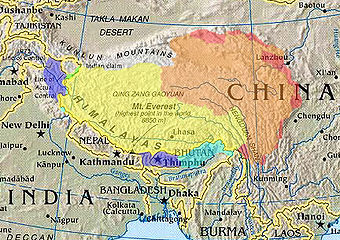Lhasa, Tibet (China) -- In its Annual International
Religious Freedom Report released on 30 July 2012, the US held the
Chinese government responsible for the wave of self-immolations amongst
Tibetans over the recent years (45 deaths so far).
 It
identified that ‘there was marked deterioration’ in the government’s
approach in handling religious issues during 2011 and increased
restrictions were placed on religious practices especially in Tibetan
Buddhist monasteries and nunneries. Beijing’s obvious immediate reaction
has been to ridicule the report as being highly prejudiced, arrogant
and ignorant. However, it is beyond doubt that the concerned actors are
giving up their lives to send a definite message across the
international community.
It
identified that ‘there was marked deterioration’ in the government’s
approach in handling religious issues during 2011 and increased
restrictions were placed on religious practices especially in Tibetan
Buddhist monasteries and nunneries. Beijing’s obvious immediate reaction
has been to ridicule the report as being highly prejudiced, arrogant
and ignorant. However, it is beyond doubt that the concerned actors are
giving up their lives to send a definite message across the
international community.
These are against religious repression, or for an end to the colonial
style administrative set up, or against the forced patriotic education
campaigns. Paradoxically, they are also cognizant of the fact that such
acts are intrinsically a violation of their own religious beliefs and
pacifist way of life. Then why have they turned to self-immolation as a
strategy? This article makes a socio-psychological foray into the
underpinnings of ‘self-immolation’ as a phenomenon and whether it will
prove to be an evolutionarily stable strategy.
Altruism
Three particular concepts can be adduced to explain the rationale behind
these self-immolations. First, the concept of ‘altruistic suicide’, a
term popularized by Emile Durkheim in context of a community-bound
consciousness which propels one to sacrifice for the benefit of others.
Durkheim identified that individuals who commit such acts feel
overwhelmed by a group’s goals and beliefs and are highly integrated
into the norms and customs of a society. In the Tibetan case, a
significant proportion of these monks are institutionally integrated via
their religious scriptures and practices into a code of beliefs,
religious freedom being the principal one. Their identification as a
single community as opposed the rest of Chinese citizens (barring other
autonomous regions) provides greater scope for integration within the
group. And though it would be an unfair comparison to make, but
altruistic suicides seem to be emerging as an alternative strategy for
these non-state actors given the stress on non-violence amongst Buddhist
practitioners, and as a corollary, their inability to endorse suicide
terrorism as a way to force the governments to yield to their cause.
Fatalism
Secondly, fatalism as an attitude has also contributed to the growing
levels of frustration amongst the Tibetan population who for the lack
of options feel excessively regulated and choked by oppressive
discipline by the Chinese authorities. They face, what in the terms of
Game theory would be called, Prisoner’s dilemma, where cooperation with
fellow Tibetans would manifest in achieving the goal of a free Tibet
while destabilizing the Chinese state and noncooperation would result in
the obliteration of their own ilk.
Anomie
Thirdly, the concept of Anomie also helps to explain the
directionless-state of the Tibetans who reflect moral confusion and lack
of social direction due to the two-directional pull from the Chinese
state and the Tibetan fraternity. They confront conflicting choices due
to lack of definitions on legitimate aspirations within a framework of
desirable social ethics, which could otherwise impose meaning and order
on the individual conscience. Pursuit of desires is restrained by
constant abuse and excessive regulation. Viewed from this prism, the
endorsement of self-immolations as a strategy could evince a breakdown
of moral regulation within the Buddhist paraphernalia as well as Chinese
visions of integration of its autonomous regions.
Inadvertently, a mix of the above mentioned three factors explains
the occurrence of this phenomenon in Tibet, but will it prove to be an
evolutionary stable strategy is a question that requires further
probing.
Self-Immolations as Evolutionary Stable Strategy?
Two crucial factors need to be kept in mind while assessing the
potential for success of this strategy: first, the nature of the Chinese
state and second, the sustainability of the strategy itself. In a
certain way, an unyielding authoritarian polity provides enough space
for devising a stable strategy as the reactions are largely predictable
and the element of surprise is greatly reduced, though execution is a
problem in the long run. For self-immolations to succeed it would
require larger participation from the Tibetan community, which seems to
be a dim possibility in this case. In the long-run the strategy might
run out of steam as the grave personal losses encumbered by the
community as a whole could impinge on the larger Buddhist precepts thus
drawing rebuke from the spiritual gurus. Also, it seems impracticable as
no specific time-frame can be ascertained to achieve their aspired
goals which will render the efforts of the martyred few fruitless.
There is a pressing need for correction of their strategy by the
Tibetans so as to not advance the anomie resulting from the amalgamation
of religious and political ends. Moreover, the credentials of
self-immolations as an evolutionarily stable strategy are highly
questionable.
------------
Bhavna Singh is a Research Officer for CRP, IPCS